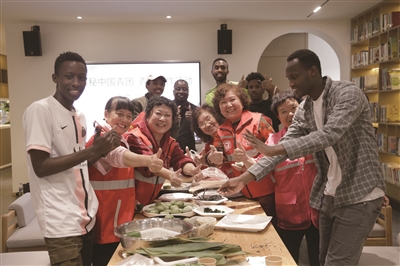
Foreign friends enjoyed making Qingtuan last Sunday. Photo: Jin Yingying
Event
By Jin Yingying
The Qingming Festival is an annual day for the traditional tomb yard sweeping trips of extended families to commemorate their ancestors and the deceased family members. It is set on April 5. As a part of the age-old tradition in Hangzhou, people would make qingtuan, or green rice cakes during this time.
Originally made for a sacrificial purpose, qingtuan has been passed down for over 1,000 years with no changes to its appearance. It has since become a seasonal snack with a strong connection to the festival.
Qingtuan is made of glutinous rice and the Chinese mugwort and is commonly filled with either sweet sesame pastes or salty stuffing. The Chinese mugwort, also known as aicao(艾草), is a herbaceous perennial plant with a far-reaching rhizome that has been used as an herbal medicine believed to improve liver, spleen, and kidney health.
In spring, making qingtuan has become a must-do in Hangzhou. The tender and juicy Chinese mugwort adds a unique flavor, texture, and green color to the rice cakes. The herb can be found all over the countryside. It often grows alongside wild vegetables such as ka-limeris and water celeries.
How to differentiate the Chinese mugwort from other potherbs? A group of foreigners living in Hangzhou joined an event organized by Hangzhoufeel to pick up the Chinese mugwort and make qingtuan on April 2 at the Xiaoying subdistrict in Shangcheng district.
"The reverse side of the leaves are white and the leaves are in their most tender period. You may smell the fragrance," said a lady working for the Jade Emperor Hotel, in the yard of which the herbs can be easily spotted. After coming back with fruitful results with her help, the international participants went on to learn how to make this chewy snack under the guidance of some volunteers from the Xiaoying community.
The leaves they picked were boiled with a spoon of baking soda for around 30 minutes before being mixed with the glutinous rice flour. Kneading the dough was not an easy task. The seven internationals took turns to finish the process.
Two kinds of fillings were prepared: one was the sweet sesame pastes and the other bamboo shoots fried with pork. After making the dough into a roll and cutting it into small portions, they spread them into thin and round wrappers. To distinguish the different fillings, they made the salty-stuffed qingtuan into a dumpling-like semi-spherical ones. Nelson added a tiny piece of dough on his qingtuan to make it recognizable after being steamed.
The international group of visitors finally got their green rice cakes. The salty-stuffed qingtuan won by a landslide as it is preferred by the six out of the seven gentlemen.
"So yummy!" Josiah from Rwanda said he had never tried this kind of snack before, nor had he seen any similar food in his hometown. Either sweet or salty, they are uniquely tasty.
